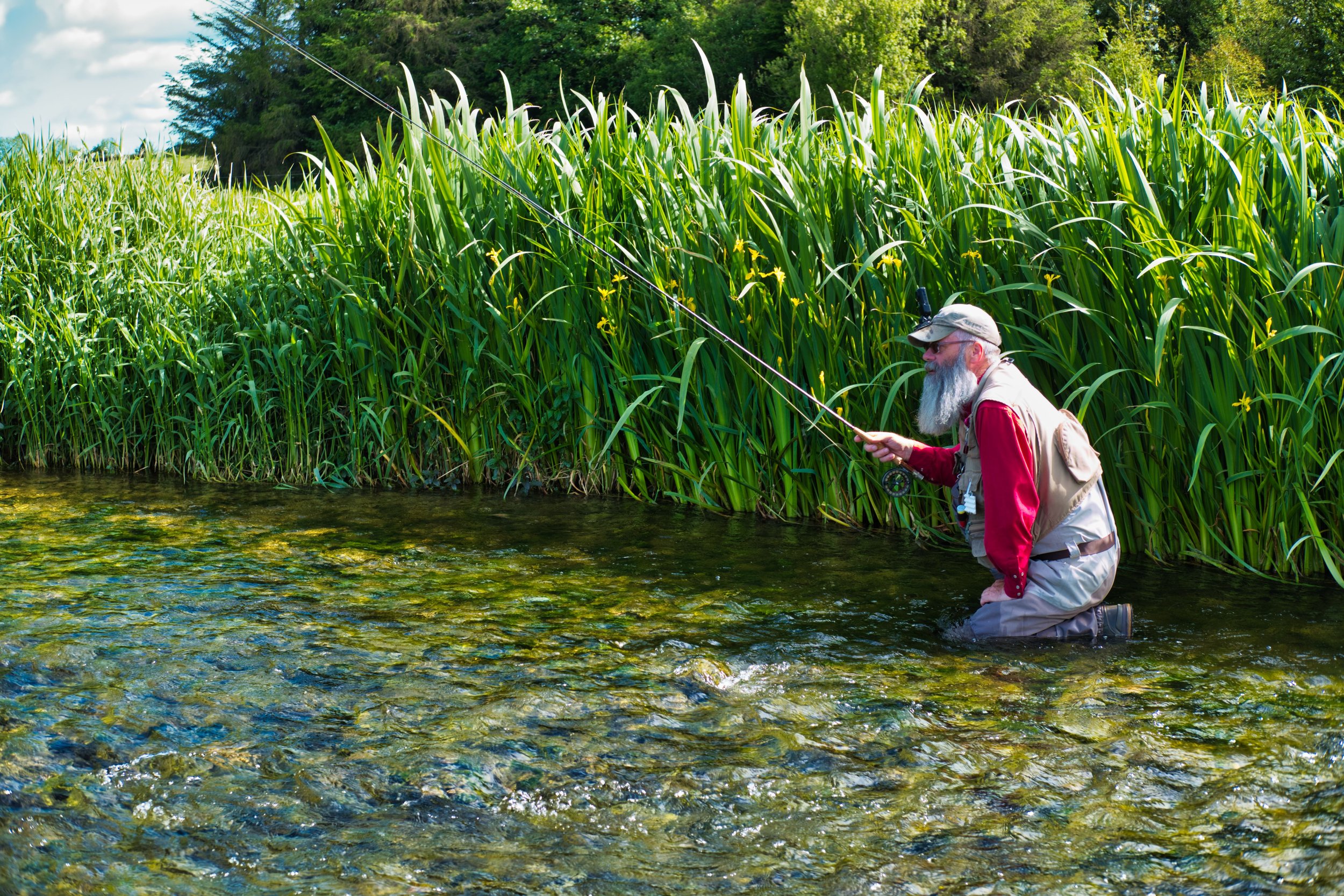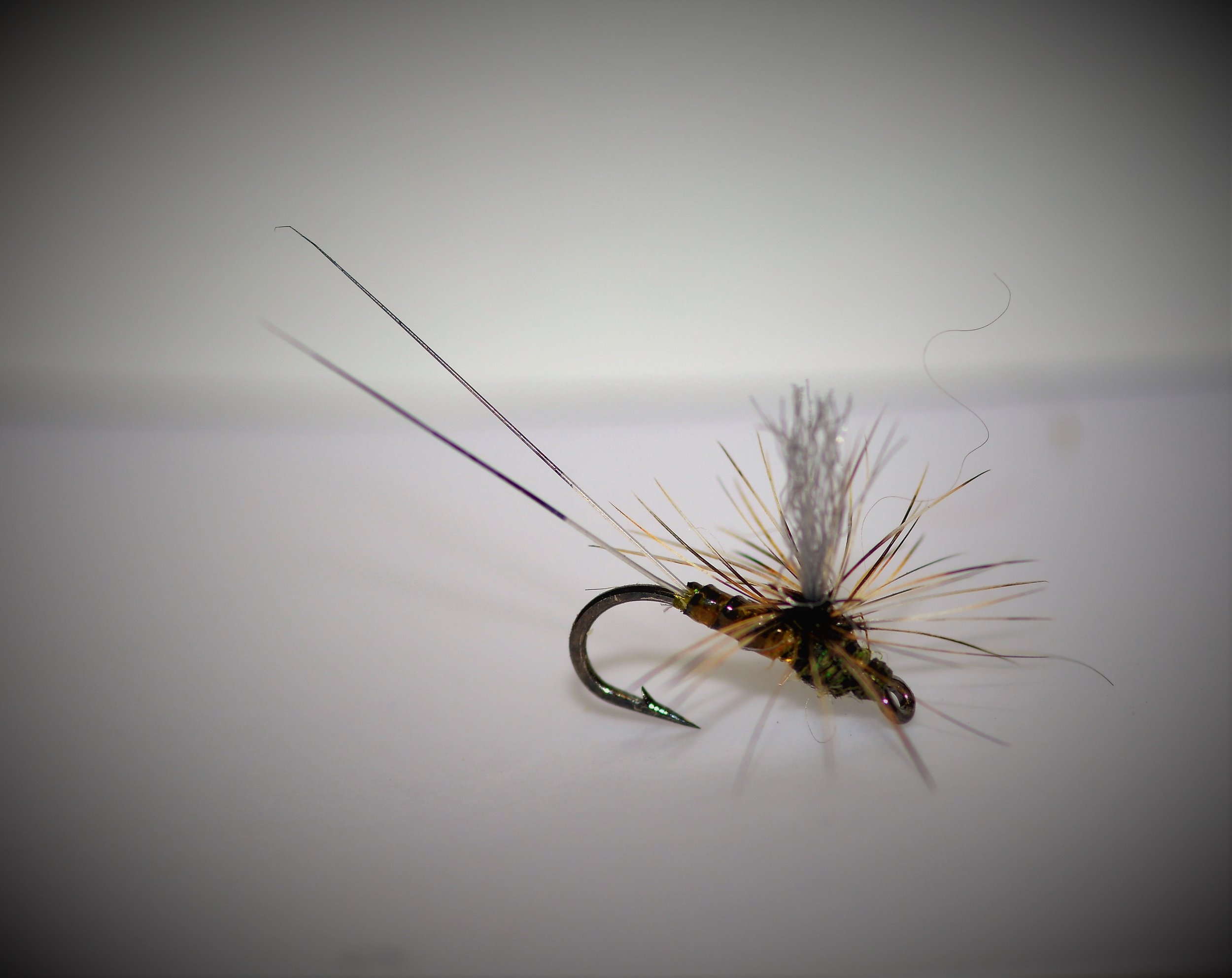
George McGrath
I started fly fishing nearly half a century ago on my local river Suir, back then probably the finest dry fly fishery in Europe. Fly hatches were prolific, and hardly a day passed during the season when trout didn't rise, sometimes for protracted periods and even sometimes all day long. So the dry fly was the obvious choice, and the first fly I ever cast was in fact a dry fly, somewhat unusual as most beginners started with the wet fly. Regrettably, in common with many rivers, the hatches on the Suir have declined, and now the rises are more difficult to predict, hatches are more sporadic and the flies no longer appear every day. However, fishing can still be spectacular and very rewarding when the right conditions prevail. I like many of my generation started with very primitive equipment, I had a bad fibreglass rod, a worn out reel and a Kingfisher silk line that refused to float despite every effort to dry it and treat it. But despite these handicaps I caught fish and I also caught the flyfishing bug which has stayed with me ever since.The equipment I now use, needless to say, is a huge advancement, I deliberately fish as light as I possibly can, a 9 foot 3 weight rod, as light a reel as I can find, and a double tapered line. I also use a Sage LL 7 foot 9 inch 3 weight for summer evening fishing. I like it light because to get the best of the spooky Suir trout lightness and delicacy are imperative.The choice of a double tapered line is for me an essential element in delicate presentation, the Suir trout won't tolerate any heavy or clumsy efforts at presenting the fly, and will treat such efforts with the distain they deserve. Other than that, good waders, eye protection, gink and a sharp snips to cut line and I'm ready to fish.
As regards leaders I keep it very simple, I use Maxima tapered leaders in the most appropriate diameter for the prevailing conditions, adding about a metre of tippet, decreasing the diameter as river levels drop, typically 7x in spring and reducing size to 8x in low water summer conditions.I tend to use the heaviest the trout will tolerate.
My approach to rising trout whether you catch him or not. I learned very early on to be stealthy, because if you're not you will fail. Anyone can go to the river and in theory catch a trout, but to do it consistently under differing conditions is what seperates the men from the boys, it's no accident that 90% of the fish are caught by 5% of the anglers. Flyfishing a dry fly to a wild trout that is superbly adapted and attuned to its environment is hunting in its truest form.If that trout obliges and accepts your offering it's a vindication of your strategy and indeed your skill and technique as a hunter of fish. And this takes some learning and a certain amount of natural ability, I have noted through the years that those who fish and are also hunters tend to excel at flyfishing.
Reading the water is an essential skill for the flyfisher, again a skill developed over time, like most beginners when I started fishing I walked past many fish and fish holding areas for lack of water reading skills. When I guide on the river I am often asked by a client "how did you know he was there”? and then when I explain how I knew ,I almost always get the same reply, "wow, that makes perfect sense, now I understand". Or,"why didn't that occur to me". Of course it also helps if one is intimately acquainted with the river concerned,as for the most part trout will be in the same places year after year.
I don't consider myself a good caster, for instance I have never taken any instruction, maybe some day. I make up for it by getting as close to my quarry as possible, I try to get within 2 to 3 rod lengths if at all possible, the closer one is the less chance of making a mistake. I long ago learned that long casts were counter productive and getting up close and personal was far more fruitful, again emphasising the importance of stealth. Most casts are taken upstream but if it can be avoided at all, never directly over the rising fish, far better and more likely to elicit a positive response is the angled cast. From either the left or right of the fish a fly dropped about 6 inches above and at an angle will most times get you your fish, any further, and if he's educated he may have too much time to study your offering and see it for what it really is, and consequently turn up his nose in distain.Occasionally a downstream cast may be required because of where a fish may be lying, or if he is known to be particularly leader shy.
Whilst I wouldn't claim to be any kind of expert entomologist, I am familiar with most of the insects that are to be encountered on the river, in particular those that are of interest to the trout.It behoves the angler to learn as much as possible about these insects in order to maximise his enjoyment of the angling experience.I am often asked "what fly will you use tomorrow"?my reply is always the same,"i won't know that until I reach the river tomorrow". Of course whilst fly choice can be very important, I also think, to a degree, that too much can be made of it. There's the school of exact representation,those claiming that the fly has to be an exact copy of the natural insect that the trout are currently feeding on,this in my view is nonsense,even the best efforts of the best flytyers can hardly be described as an exact copy!
Rise forms are a good general indicator of what a trout may be feeding on,and it is wise for the angler to gain at least a passing familiarity with the different rise forms. A gentle sipping rise generally means the insect that the trout is taking is either incapacited or dead and unlikely to escape, ie a spinner or a cripple. A more urgent rise form probably means that the trout needs to hurry as the insect may escape, possibly an emerger, and the splashy hurried rise of the trout chasing an escaping fly, possibly a hatching or skating caddis.All important knowledge in making an informed choice when choosing a fly.
I have been tying flies for almost as long as I've been fly fishing, again in the early days making do with very limited materials, I made the best of it, and soon learned that one didn't need an extensive amount of materials to make flies that caught fish.Over time I learned that size and overall shape were for me the critical ingredients, colour was of secondary importance.I found that a well presented fly that was of the right size and shape almost always got a positive response, even from very spooky well educated trout. Even today with a wealth of materials at my disposal I still keep it very simple and stick with what works. My favourite fly is without doubt the Sherry Spinner, summer evenings on the Suir are nothing short of blissful when this little insect makes its appearance. Again tied simply with just three materials, it is devastatingly effective when presented nice and gently to those large Suir fish, sucked down without a hint of suspicion.
My presentation style can be very simply described....up close and personal...
Fighting fish is an art form in itself, I try to keep them off balance with the use of side pressure,I apply side strain to the right and when the fish finds his balance I immediately bring to bear strain from the left,this soon beats them down and I then quickly unhook and release them to fight another day.
In summary,I have spent vast parts of my time on earth on the river,I don't regret a single moment,I feel a very deep connection to the riverine environment and especially with all those who reside there, in particular the beautiful wild brown trout which have brought me such joy through the years,I will continue to fish as long as I have the wherewithall.
For any of you who may be interested I have a YouTube channel which contains considerable flyfishing content, check it out. Gundog and Fly.
















